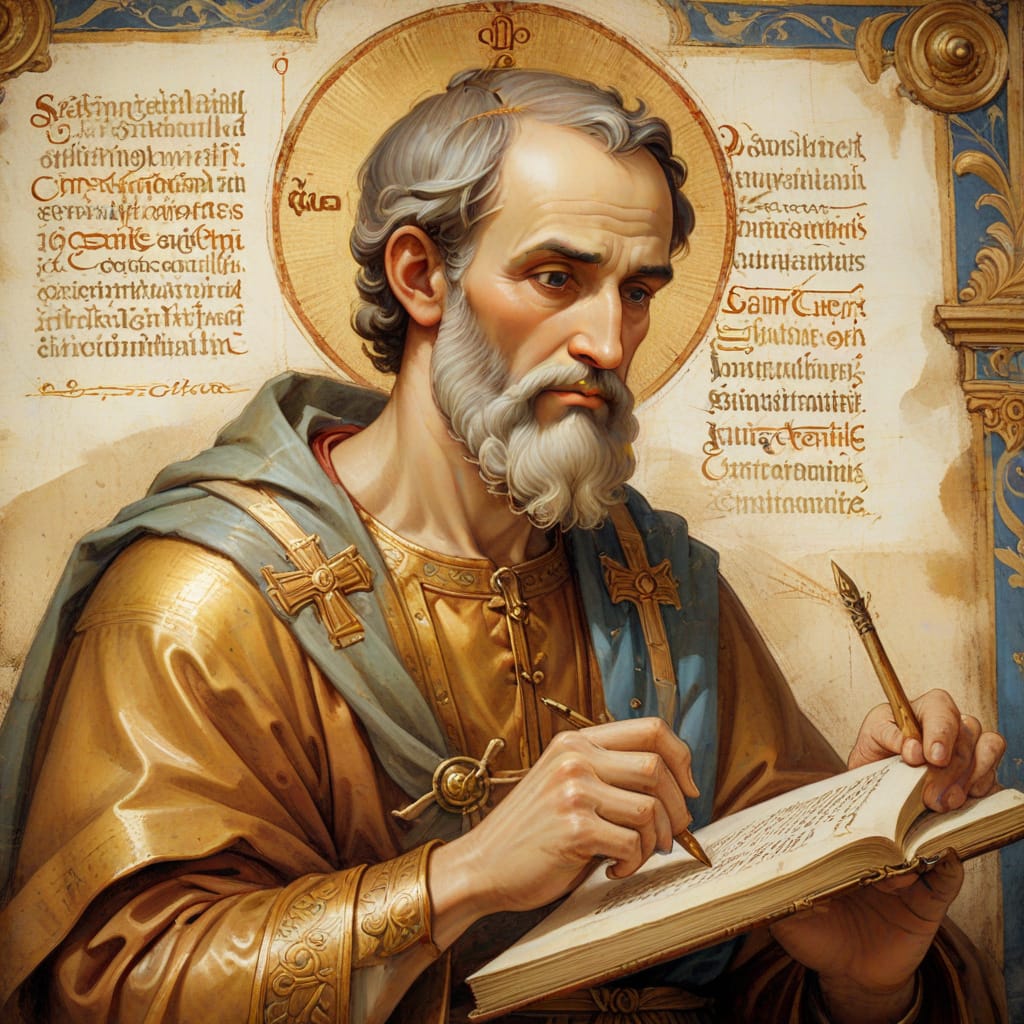
Clement of Rome, also known as Pope Clement I, served as the Bishop of Rome during the late first century. He is widely regarded as one of the first of the Apostolic Fathers of the Christian Church .Details regarding Clement’s life remain limited. According to Tertullian, Clement was ordained by Saint Peter. Early ecclesiastical records list him as either the second or third bishop of Rome. Eusebius, in his “Church History,” describes Clement as the third bishop of Rome and refers to him as a “co-laborer” of the Apostle Paul. Irenaeus, in “Against Heresies,” identifies Clement as the successor to Anacletus, the third bishop of Rome, and notes that he personally knew the Apostles.

The sole surviving authentic writing attributed to Clement is his letter to the church at Corinth ( First Letter of Clement), which was composed in response to a dispute concerning the deposition of certain presbyters. In this letter, he emphasized the authority of presbyters as appointed by the Apostles.

This document is among the earliest existing Christian writings outside the New Testament and was read publicly in Corinth alongside other epistles, some of which later became part of the biblical canon. The letter is recognized as the earliest explicit statement of the principle of apostolic succession.
Clement is venerated as a saint in numerous Christian traditions and is regarded as a patron saint of mariners. He is commemorated on November 23rd in the Catholic Church, the Anglican Communion, and the Lutheran Church. In Eastern Orthodox Christianity, his feast day is observed on November 25th.

The “Annuario Pontificio” lists Clement as the fourth bishop of Rome, serving toward the end of the 1st century. It is generally believed that Clement died in exile, possibly as a martyr. Early apocryphal accounts, dating from the 4th century and attributed to authors such as Rufinus, suggest that Clement was imprisoned by Roman Emperor Trajan and executed by being tied to an anchor and cast into the sea. The “Liber Pontificalis” indicates that Clement died in Greece during the third year of Trajan’s reign, around 100 AD.
The Legacy of St Clement of Rome
St. Clement of Rome made significant contributions to the development of early Christian church structure and community cohesion through his esteemed correspondence with the Corinthian congregation. His writings underscore the importance of doctrinal unity and respect for ecclesiastical authority, serving as a foundational reference for subsequent church leadership principles. Clement of Rome’s theological perspective, as articulated in his First Epistle to the Corinthians, underscores the significance of Christ’s atoning work, emphasizing that Jesus Christ willingly offered his blood and flesh for the salvation of humanity. His teachings advocate for the importance of maintaining order, humility, and harmony within the Christian community, drawing upon Old Testament scriptures and apostolic traditions to promote unity and appropriate conduct among believers. Additionally, his theology highlights the glory of God, the vital role of the Holy Spirit, and a practical understanding of justification by faith that naturally manifests in righteous actions.
Key Aspects of His Legacy
First Clement (I Clement): Epistle
His notable epistle, approximately dated to 95 AD, addresses divisions within the Corinthian church and encourages submission to established ecclesiastical leadership, particularly emphasizing the role of bishops.
Church Order and Authority:
Clement’s letter offers valuable insights into early Christian organizational frameworks, highlighting the significance of maintaining order, unity, and honoring church authority to safeguard doctrinal integrity.
Apostolic Succession:
He emphasized the importance of hierarchical continuity, asserting that Christ instituted this structure, which is maintained through the legitimate successors of the apostles.
Unity and Peace:
A central aim of Clement’s correspondence was to foster reconciliation and stability within the Christian community, establishing principles that continue to influence ecclesiastical cohesion.
Eschatology:
Clement’s theology includes an emphasis on the future kingdom of God, which he connects with the importance of resisting present pleasures and living in anticipation of Christ’s return. He uses illustrations, such as the phoenix, to explain concepts like the resurrection.
Soteriology:
Clement of Rome’s soteriology emphasizes salvation through divine grace, mediated by Christ’s sacrifice, and activated by faith and virtuous works. His teachings highlight the ongoing process of salvation, beginning with baptism and encompassing repentance, a life of piety, and the importance of following Christ’s example for ultimate reconciliation with God.
Key Aspects of Clement’s Soteriology
- Grace as God’s Gift: Clement saw salvation as a gracious gift from God, enabling humanity to be reconciled with Him after the Fall.
Christ’s Atoning Sacrifice:
The death of Jesus Christ on the cross is central to Clement’s theology, serving as the pivotal event for atonement and the means by which humanity can reconnect with God.
Faith and Works:
While grace is foundational, Clement also integrated the necessity of human participation through faith and good works. This includes a life of repentance and living a virtuous existence in imitation of Christ.
The Process of Salvation:
Clement understood salvation not as a single event but as an ongoing process that begins with baptism and requires sustained effort and transformation to achieve complete holiness.
The “Fear of God”:
The concept of the “fear of God” is central to Clement’s understanding of a life dedicated to God, suggesting reverence, a profound respect, and obedience to divine law as crucial for spiritual progress.
Rejection of Gnosticism:
As a proto-Orthodox theologian, Clement’s work includes a rejection of Gnostic ideas, particularly their focus on special knowledge rather than grace and works, and their rejection of God’s established law
Martyrdom:
Tradition holds that Clement endured martyrdom, reportedly being executed by being bound to an anchor and cast into the sea under the imperial reign of Trajan. This act embodies the enduring faith and hope central to Christian witness.
Influence on the Development of the Papacy:
His writings and leadership underscored the significance of the Bishop of Rome as a primary ecclesiastical authority, influencing the trajectory of papal prominence.
Veneration:
Clement is honored as a saint in multiple Christian traditions—including Catholic, Anglican, and Orthodox churches—with his feast days observed on November 23 in the Western tradition and November 25 in the Eastern tradition.
Apostolic Father:
Recognized as one of the Apostolic Fathers, Clement is esteemed for his direct connections to the apostles Peter and Paul and for faithfully transmitting their teachings to succeeding generations.
Key Theological Concepts:
Christology:
Clement describes Jesus as a divine sovereign and high priest, who offers himself sacrificially on behalf of his followers.
Atonement:
He affirms the doctrine of substitutionary atonement, stating that “Jesus Christ our Lord gave His blood for us by the will of God; His flesh for our flesh, and His soul for our souls.”
Justification and Faith:
While the precise nuances of Clement’s view on justification are subject to scholarly discussion—some interpret it as faith alone, others as a cooperative process involving faith, works, and grace—there is consensus that genuine faith naturally results in good works.
Church Order and Authority:
Clement emphasizes the importance of proper church governance, advocating for elders (presbyters) appointed through community consensus. His involvement in correcting disorder within the Corinthian congregation reflects an early understanding of the universal church’s unity.
Practical Living and Morality:
He offers practical guidance for living out Christian principles daily, including advice on family life, and encourages virtues such as humility and patience.
Glory of God:
A central theme in his theology is the glorification of God, with Christ’s salvation serving ultimately to manifest the Father’s glory.
Use of Scripture:
Clement frequently references Old Testament passages and oral traditions about Jesus to substantiate his teachings, demonstrating the central role of Scripture in moral and doctrinal instruction.
Context and Application:
Writing from Rome to the Christian community in Corinth, which was facing internal conflicts, Clement’s letter serves as a call for unity and a response to internal challenges. His message combines Christian doctrine with rhetorical persuasion and Stoic virtues, illustrating the interconnectedness of early Christian churches and Rome’s emerging role as a significant center of ecclesiastical concern, prior to the development of a formal papacy.